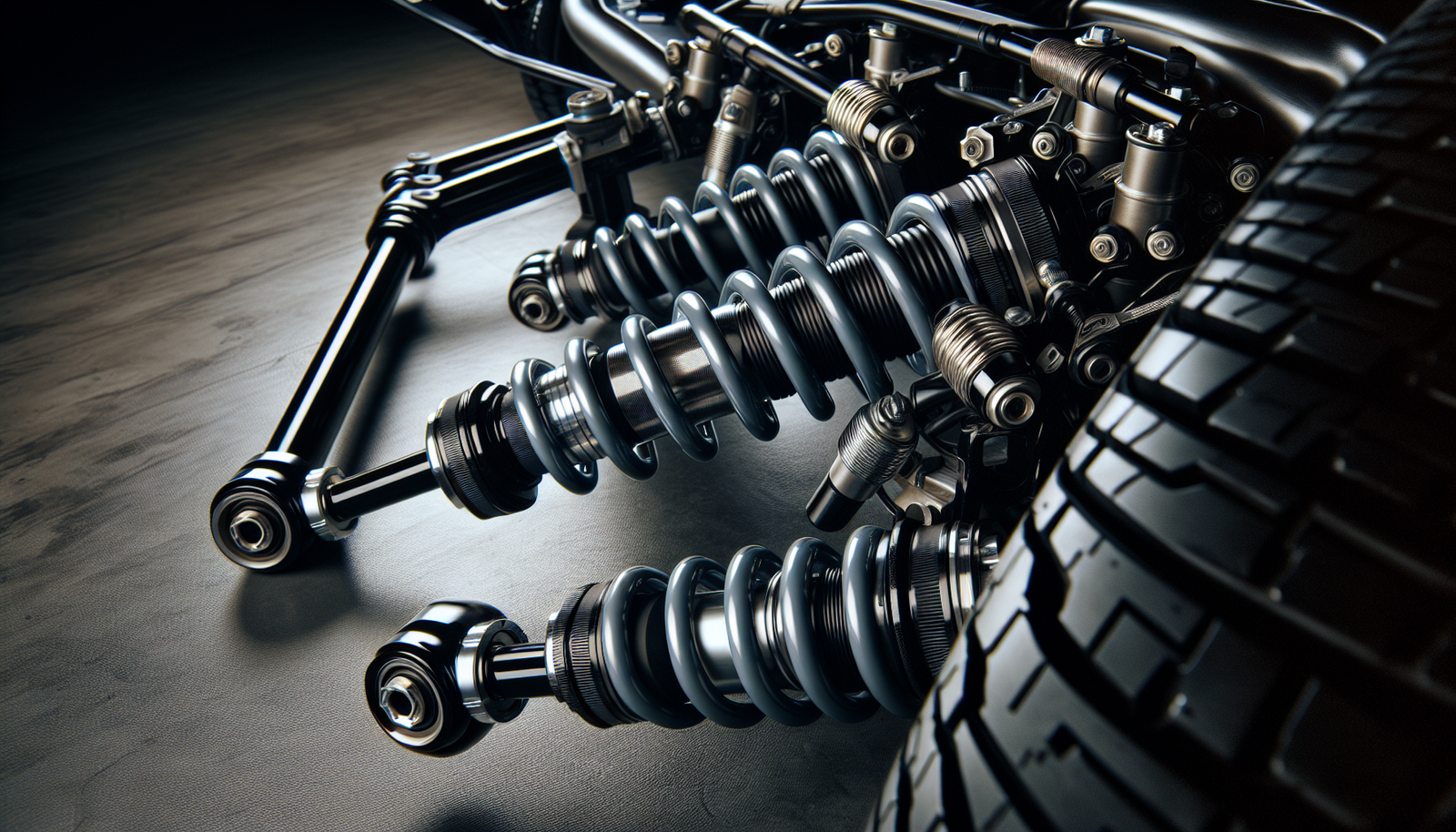
Embarking on the journey to master the ride of your vehicle is both exciting and crucial for your driving experience. “Mastering the Ride: Choosing the Right Suspension Kit” is your go-to guide for understanding the intricacies of suspension systems and ensuring that your selection elevates your vehicle’s performance to its peak. Whether you’re aiming for improved handling, a smoother ride, or a certain aesthetic, this comprehensive article will illuminate the path to finding the perfect suspension kit tailored just for your automotive needs. Strap in and prepare to transform the way you drive with knowledge and confidence.

This image is property of images.pexels.com.
Understanding Suspension Systems
Basics of Suspension Mechanics
You may have wondered how your vehicle manages to stay grounded and stable over various terrains. This is where your vehicle’s suspension system comes into play. The suspension system is crucial for minimizing the impact of road conditions, ensuring tire longevity, and maintaining vehicle stability. At its core, the system’s goal is to provide a smooth ride by absorbing the energy from bumps and uneven surfaces, which is achieved through a series of springs, shock absorbers, and linkages.
Types of Suspension Systems
When it comes to suspension systems, there’s a diverse range of designs you can choose from. The most common types are dependent and independent suspensions. Dependent systems, typically seen in older or more heavy-duty vehicles, connect opposite wheels through a rigid axle, ensuring they move together. In contrast, independent systems allow wheels to move independently, which can lead to better handling and a smoother ride, common among modern passenger vehicles. Apart from these, there are also semi-dependent and adaptive systems that offer varied performance benefits.
Function and Role in Vehicle Stability
The main function of your vehicle’s suspension system is to provide structural support, manage tire movement, and absorb shocks from the road surface. The system directly influences vehicle stability, making it pivotal during cornering, acceleration, and braking. A well-tuned suspension setup will keep your car balanced, ensure tires have constant contact with the road, and help you maintain control in various driving conditions. Overall, the suspension is a key component in how your vehicle feels and behaves on the move.
Assessing Your Vehicle’s Needs
Determining Vehicle Usage
Before diving into the intricacies of suspension kits, it’s important to consider how you use your vehicle. Are you someone who enjoys off-roading adventures on rugged terrain, or do you stick to paved, urban paths? Your unique driving patterns play a significant role in deciding the type of suspension system that’s best for you. Analyze your typical vehicle usage, and let that guide your suspension decisions.
Analyzing Current Suspension Performance
Take a moment to evaluate your vehicle’s current suspension performance. Do you notice too much body roll during turns or an uncomfortable amount of bounce on rough roads? These signs can indicate that your suspension system needs attention. It’s important to be mindful of how your vehicle handles in different conditions to decide if, and what kind of, an upgrade is necessary.
Identifying Ride Quality Objectives
Think about what you want from your ride. Are you looking for comfort, stability, or maybe a sportier feel? Your objectives can range from enhancing your vehicle’s load-carrying capacity to improving your driving experience with tighter handling. By pinpointing exactly what you’re aiming for in ride quality, you’ll be better equipped to select the most suitable suspension kit for your needs.
Types of Suspension Kits
Lift Kits
For the off-road enthusiast in you, lift kits are a fantastic choice. These kits raise your vehicle’s body or suspension, allowing for greater ground clearance and the fitment of larger tires. Not only do lift kits improve your vehicle’s off-road capabilities, but they also give it a more imposing stance.
Lowering Kits
If a lower center of gravity and improved aerodynamics on the tarmac are what you crave, consider a lowering kit. By reducing the ride height, you get decreased wind resistance and a lowered roll center. This generally leads to enhanced handling, offering a sportier and more aggressive feel when you’re behind the wheel.
Leveling Kits
You might notice that some vehicles have an uneven stance – typically higher at the rear. This is especially true for trucks and utility vehicles. Leveling kits aim to rectify this by raising the front of the vehicle so that it is consistent with the rear, resulting in a perfectly horizontal line that not only looks better but may also help with handling.
Performance Suspension Kits
Want the best of all worlds? Performance suspension kits are engineered to improve handling, comfort, and sometimes even vehicle aesthetics. They often come with stiffer springs and shock absorbers that can handle the extra demands of spirited driving, and are typically adjustable to help you dial in your preferred setup.
Key Components of Suspension Kits
Shocks and Struts
Shocks and struts are vital for damping the motion of the vehicle sprung mass. They play a huge role in how your ride feels. Quality shocks and struts can dramatically enhance vehicle comfort and handling by keeping your tires in contact with the road and controlling spring oscillation.
Springs
Coil springs, leaf springs, air springs – these are just a few of the types you may encounter. Springs are designed to support your vehicle’s weight and absorb the initial impact of road irregularities. Opting for a heavier-duty or performance-oriented spring can change your vehicle’s ride height and stiffness.
Control Arms
The control arms connect the suspension to the vehicle’s frame. Upgraded control arms might be necessary for larger kits to ensure correct wheel alignment and suspension geometry. Choosing high-quality control arms will affect your vehicle’s responsiveness and wheel travel.
Bushings and Bearings
Small yet significant, bushings and bearings work as interfaces between two parts, allowing limited movement and reducing vibrations. Upgrading these to more durable options can refine your vehicle’s handling characteristics by providing a firmer, more precise wheel control.

This image is property of images.pexels.com.
Material and Build Quality
Understanding Material Differences
Suspension components can be crafted from various materials, including steel, aluminum, and composites. Each material has its traits; for instance, steel is known for its strength, while aluminum is lighter. When picking a suspension kit, it’s critical to understand how these material choices will influence durability and performance.
The Impact of Construction on Durability
The build quality of suspension parts is as significant as their material composition. A kit’s reliability and longevity depend on how well it’s constructed. From welding quality to surface coatings that resist corrosion, every detail matters. Reliable construction ensures that your suspension can endure the stress of different driving conditions.
Warranty and Manufacturer Support
A quality suspension kit should come with a reassuring warranty and solid manufacturer support. Knowing that you have access to assistance in case of a defect or an issue can be a huge relief. Always check the warranty terms and make sure you’re comfortable with the level of support provided before making a decision.
Compatibility and Fitment
Ensuring Vehicle-Specific Fit
Every vehicle has unique suspension design intricacies. It’s imperative to choose a suspension kit that’s specifically designed for your make and model to avoid issues with fitment. Incorrectly matched components can lead to poor performance, safety risks, and even damage to your vehicle.
The Importance of Proper Alignment
After installing any suspension modification, a proper wheel alignment is essential. It ensures that your tires meet the road at the correct angle, helps prevent uneven tire wear, and maintains optimal handling characteristics. Always budget for a professional alignment after installing a new suspension kit.
Integration with Existing Systems and Components
Your suspension system interacts with multiple other systems, including steering and braking. When selecting a suspension upgrade, make sure it integrates well with these existing systems. Compatibility is key to maintaining the sophisticated balance of vehicle dynamics.

This image is property of images.pexels.com.
Installation Considerations
DIY vs. Professional Installation
You might be tempted to install a suspension kit yourself, especially if you’re mechanically inclined and have access to the necessary tools. However, it’s worthwhile to consider professional installation to avoid potential complications. Remember, your safety on the road is paramount, and there’s no replacement for the expertise of a skilled technician.
Required Tools and Equipment
Whether you opt for DIY or professional help, be aware of the tools and equipment required for a suspension kit installation. These will likely include an array of specialized wrenches, jacks, and possibly spring compressors. Preparing the necessary items beforehand can make the installation process smoother and quicker.
Understanding the Complexity of Installation
Each suspension kit comes with its level of installation complexity. Some may simply replace the existing shocks and struts, while others require more comprehensive modifications. Always assess your skill level and understand the scope of the work involved before undertaking the installation.
Performance and Handling Improvements
Enhancing Off-Road Capability
With the right suspension upgrade, like a lift kit, your off-road capabilities can dramatically increase. You’ll find that you have better obstacle clearance, a steeper approach and departure angles, and an overall more robust vehicle that can take on challenging terrain.
Improving On-Road Handling
For those of you who stick to asphalt, enhancements like lowering or performance kits can offer a world of difference. They can help decrease body roll, improve steering response, and give you a lower, more planted driving experience that’s great for everyday driving or even track days.
Adjustability Features in Suspension Kits
Many modern suspension kits come with adjustability features, allowing you to fine-tune aspects like ride height and damping rates. This flexibility means you can adapt your vehicle to different situations or preferences, whether you’re looking for comfort or performance.

Budgeting for a Suspension Upgrade
Costs of Suspension Kits
The costs of suspension kits can vary widely based on the type, quality, and intended use. Simple leveling kits may be on the lower end of the cost spectrum, while comprehensive performance kits tend towards the higher end. Remember to factor in additional costs such as labor, alignment, and possibly upgrading other components.
Long-Term Investment and Vehicle Value
Investing in a quality suspension upgrade can improve your vehicle’s longevity and performance. It can also potentially increase your vehicle’s resale value, particularly if you’re targeting enthusiasts who value high-performance upgrades. Keep in mind, though, that overly customized vehicles can sometimes have a narrower buyer market.
Avoiding Overcapitalization
It’s smart to be wary of overcapitalization—spending more on your vehicle than it’s worth. Keep your budget in check and focus on upgrades that align with your needs and the value of your vehicle. It doesn’t always make financial sense to install top-tier kits on older or less valuable vehicles.
Long-Term Maintenance and Care
Routine Inspection and Servicing
After upgrading your suspension, regular inspections and servicing are crucial for maintaining its performance. Check the components for signs of wear, such as bushing deterioration or leaking shocks, and address these issues promptly. Routine servicing will help extend the life of your suspension system.
Understanding Wear and Replacement Cycles
Each component of your suspension has its own lifespan, and it’s important to understand these cycles for proper maintenance. Shocks and struts generally need replacing more often than other parts, and driving conditions can accelerate wear. Keep track of these cycles to stay ahead of potential issues.
Maintaining Performance Through Upkeep
Lastly, remember that maintaining the performance of your suspension system isn’t a one-time affair; it requires consistent attention. By staying vigilant with routine care and addressing issues as they arise, you’ll ensure that your ride remains smooth, responsive, and safe for all your journeys on the road.

